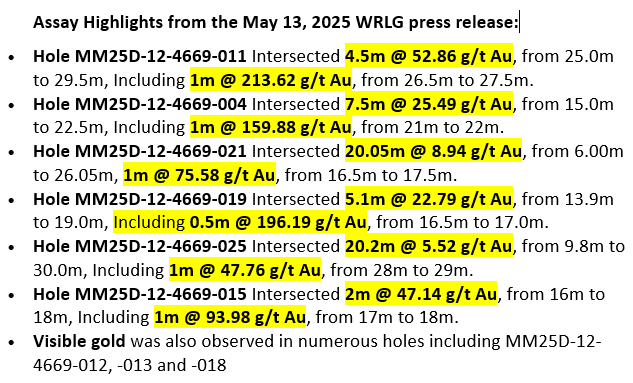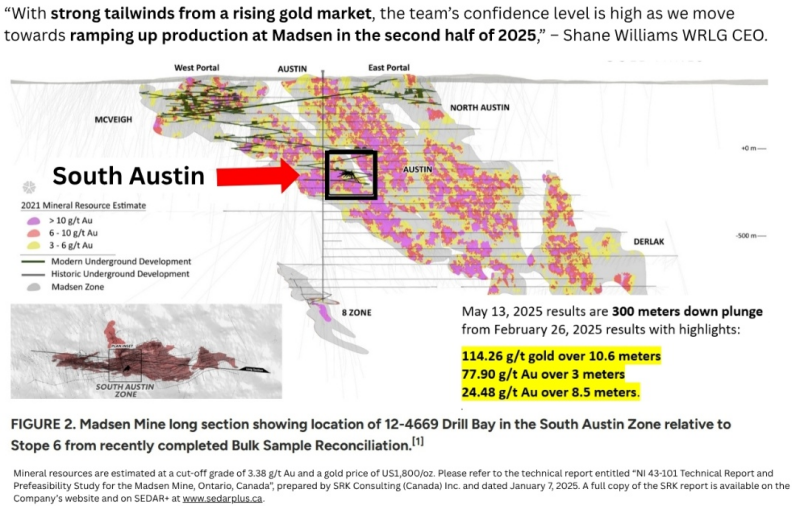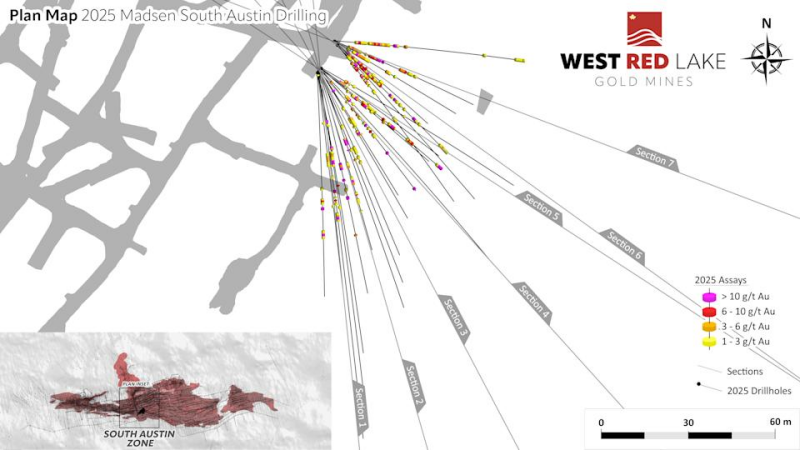 | |||||||||
 |  |  |  | ||||||
Vancouver, BC, May 15, 2025 – Global Stocks News – TheNewswire – Sponsored content disseminated on behalf of West Red Lake Gold. On May 13, 2025, West Red Lake Gold Mines (TSXV: WRLG) (OTCQB: WRLGF) reported drill results from the high-grade South Austin Zone, which currently contains an Indicated mineral resource of 474,600 ounces @ 8.7 grams per tonne gold, with an additional Inferred resource of 31,800 oz grading 8.7 g/t Au.
Hole MM25D-12-4669-024 Intersected 18.7m @ 48.97 g/t gold, from 5.3m to 24.0m, including 2m @ 428.83 g/t gold, from 20.5m to 22.5m, also including 0.5m @ 16.06 g/t gold, from 23.5m to 24.0m.
This high-grade intercept was complemented by visible gold hosted within highly deformed quartz-carbonate-diopside veinlets.
“The May 13, 2025 assay results are immediately below Stope #6 that we dropped as part of the bulk sample, and effectively extend this panel an additional 40 meters down plunge,” VP of Exploration Will Robinson told Guy Bennett, the CEO of Global Stocks News (GSN).
“When you're doing a resource calculation, you typically eliminate the outliers,” explained Robinson. “For instance, if you’ve got 100 samples reporting 2-5 grams/tonne intercepts, then 3 samples @ 80 grams/tonne, you’ll eliminate the high-grade results from the model, so that you don’t ‘smear’ high gold grades, making the zone appear richer than it is.”
“Grade-capping is a conservative approach, it’s also industry best practice,” Robinson told GSN. “Even with our short-term in-house models, we use geostatistics to determine capping grades on each individual stope model.”

While capping gold grades from high-grade outliers reduces their impact in the stope models, tightly-spaced definition drilling ensures that miners are targeting the mineralized system accurately. When that happens, high grades within the system get mined, and dilution is reduced.
“With 6-8 meter spacing, the gold complexes in McVeigh, South Austin, and Austin are well defined. They will be sequenced into the mining plan first,” stated Robinson. “We have 18 months of fully engineered mine plan ahead of us, built on high confidence ounces and tonnage. That is a big operational advantage we have compared to our predecessor.”
“With conventional sample preparation and assay methods, it’s possible to lose some gold during the crushing process. Since gold is malleable, it can turn into micro-discs and get caught in the screens during crushing ahead of assay,” Robinson told GSN.
“When the core loggers in the shack see visible gold, we’ll switch to an analysis technique that runs the crushed material through a series of screens at different size fractions. Metallic screening delivers much more accurate results in high-grade coarse gold deposits because it accounts for all the gold in the sample.”
“The bulk sample results we released last week were excellent. We achieved reconciliation results at the mill within 5% of the planned grade, tonnage and ounce profile. As we go deeper in the Madsen ore body, we're finding more zones that have visible gold, which is proving our thesis that there is still a lot of meat left on the bone at depth in the deposit.”
“When Madsen was originally mined, back in the 1940s through 1960s, gold was about $20 an ounce, which forced operators to implement highly selective mining methods, leaving a lot of gold mineralization behind. Gold is now at $3,150 an ounce, over 100 x higher. Our Pre-Feasibility Study (PFS) was built on a gold price of $1,680. The higher gold price is providing optionality within the deposit.”
“We’ll get an engineering plan on the area beneath stope#6 before rolling it into our mine plan,” concluded Robinson. “This zone could be sequenced into production next year.”
Above Image: South Austin plan view drill section showing assay highlights for Holes MM25D-12-4669-001 through -025.
“The area highlighted in this update sits just beneath Stope 6 from our recent bulk sampling program and demonstrates the growth potential and increased continuity we are seeing in the deposit at depth,” stated Shane Williams, President and CEO, in the May 13, 2025 press release.
“As the underground definition drill program at Madsen advances at depth, we continue to unlock significant value within the orebody,” continued Williams. “While the life-of-mine resource model accurately informs metal content throughout the deposit, it is tight-spaced drilling that provides the resolution needed to properly quantify and realize further upside potential from the very high-grade pockets of gold mineralization ahead of stope design.”
The Madsen deposits presently host an NI 43-101 Indicated resource of 1.65 million ounces of gold grading 7.4 g/t gold and an Inferred resource of 0.37 Moz of gold grading 6.3 g/t gold. [1 .] [2.] [3.]
The technical information presented in this news release has been reviewed and approved by Will Robinson, P.Geo., Vice President of Exploration for West Red Lake Gold and the Qualified Person for technical disclosure at the West Red Lake Project, as defined by NI 43-101 “Standards of Disclosure for Mineral Projects”.
Contact: guy.bennett@globalstocksnews.com
Disclaimer: West Red Lake Gold paid Global Stocks News (GSN) $1,750 for the research, writing and dissemination of this content.
Full Disclaimer: GSN researches and fact-checks diligently, but we cannot ensure our publications are free from error. Investing in publicly traded stocks is speculative and carries a high degree of risk. GSN publications may contain forward-looking statements such as “project,” “anticipate,” “expect,” which are based on reasonable expectations, but these statements are imperfect predictors of future events. When compensation has been paid to GSN, the amount and nature of the compensation will be disclosed clearly.
References:
-
“NI 43-101 Technical Report and Prefeasibility Study for the Madsen Mine, Ontario, Canada”, prepared by SRK Consulting (Canada) Inc. and dated January 7, 2025 (the “Madsen Report ”). A full copy of the Madsen Report is available on the Company’s website and on SEDAR+ at www.sedarplus.ca
-
The Madsen Mine deposit presently hosts a National Instrument 43-101 – Standards of Disclosure for Mineral Projects (“NI 43-101”) Indicated resource of 1.65 million ounces (“Moz”) of gold grading 7.4 g/t Au and an Inferred resource of 0.37 Moz of gold grading 6.3 g/t Au. Mineral resources are estimated at a cut-off grade of 3.38 g/t Au and a gold price of US$1,800/oz. Mineral resources as stated are inclusive of mineral reserves. Mineral resources that are not mineral reserves do not have demonstrated economic viability. The Madsen Resource Estimate has an effective date of December 31, 2021 and excludes depletion of mining activity during the period from January 1, 2022 to the mine closure on October 24, 2022 as it has been deemed immaterial and not relevant for the updated report. Please refer to the technical report entitled “Independent NI 43-101 Technical Report and Updated Mineral Resource Estimate for the PureGold Mine, Canada”, prepared by SRK Consulting (Canada) Inc., and dated June 16, 2023, and amended April 24, 2024. A full copy of the SRK report is available on the Company’s website and on SEDAR+ at www.sedarplus.ca
-
The Madsen Mine also contains Probable reserves of 478 thousand ounces (“koz”) of gold grading 8.16 g/t Au. Mineral reserve estimates are based on a gold price of US$1,680/oz. Please refer to the technical report “NI 43-101 Technical Report and Prefeasibility Study for the Madsen Mine, Ontario, Canada” available on the Company’s website and on SEDAR+ at www.sedarplus.ca
Copyright (c) 2025 TheNewswire - All rights reserved.


